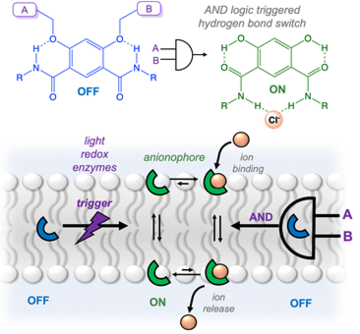- Researchers from Oxford Chemistry have developed a modular synthetic platform to make stimuli-responsive ionophores that are capable of triggered ion transport across lipid bilayer membranes.
- Their approach allows for dual-stimuli transport activation with AND logic, using biocompatible triggers relevant to targeted therapeutics: light, redox and enzymes
- Synthetic ion transporters have applications as tools for chemical biology and as therapeutics for diseases that are caused by mis-regulated protein ion channels.

AND logic triggered ionophore, where the presence of two stimuli switches on transmembrane ion transport.
In a recent study highlighted as a “Hot article” in Angewandte Chemie, researchers from the Langton and Duarte groups have developed a new class of stimuli-responsive ionophores that act as chloride anion transporters. Stimuli-responsive ionophores are biologically relevant compounds that form complexes with ions and transport them across cell membranes when activated by certain stimuli such as light, enzymes, or redox reactions.
Dr Manzoor Ahmad, working with PhD students Toby Johnson and Martin Flerin, attached stimulus-cleavable molecular cages to the ionophore. This allowed them to control the intra-molecular hydrogen bonding pattern to switch on chloride binding and transport, by applying triggers of relevance to targeted therapeutics such as light, biologically relevant oxidants and reductants, and enzymes (see Figure).
By integrating two cages responsive to different stimuli, the team engineered a system where two stimuli are both required to trigger ion transport across the lipid membrane. This unprecedented multi-stimulus activation is an example of an AND logic process, with broad applications imaginable, not only in targeted therapeutics but also in engineering signalling networks and information processing in cellular systems.
The team’s strategy provides a route to stimuli-responsive ionophores for targeted activation that is much more accessible than existing methods. This is because the control chemistry can be achieved via post-synthetic modification of a highly active ionophore, opening up new prospects for ionophore-based therapeutics that could be targeted to particular regions of the body, and activated at the desired time.
Matthew Langton, an Associate Professor and Royal Society University Research Fellow in the Department who led the project, commented:
Responsive ionophores have huge potential as therapeutics, but are often difficult to prepare and to control. We are excited to exploit this readily accessible, highly modular platform in a range of applications going forwards.
This research was generously funded by a Leverhulme Trust grant entitled: “Supramolecular transporters for engineering signal networks in artificial cells”, with further support from the Royal Society and the Synthesis for Biology and Medicine CDT.
“Responsive Anionophores with AND Logic Multi-Stimuli Activation” is published in Angewandte Chemie and available at https://onlinelibrary.wiley.com/doi/10.1002/anie.202403314.